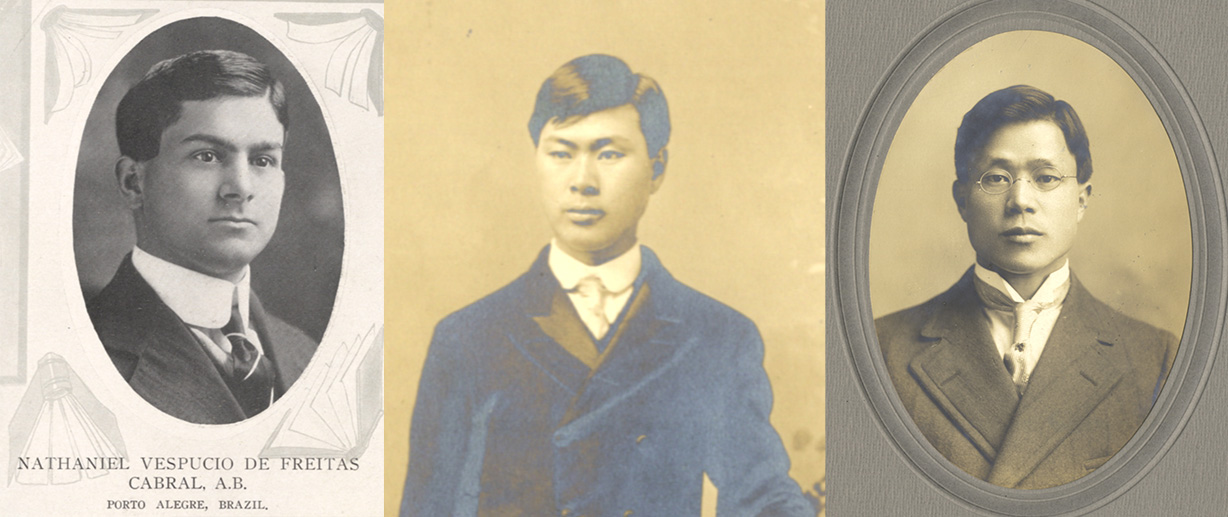By Dr. Phillip Stone ’94, college archivist
For Wofford’s first 50 years, almost all of its students came from South Carolina or nearby states. Many remained in the region after leaving the college. In the late 19th century, some faculty began traveling to Europe for graduate study, but international travel would have been a rarity for most people at the college. It seems as though Wofford’s Methodist connections, and perhaps the work of Methodist missionaries elsewhere, may have been responsible for some of the college’s first international students.
Buichi Muraoka enrolled at Wofford in September 1905, becoming the first international student to appear in the college’s records. Those records indicate that he was just shy of his 24th birthday when he came to Wofford. According to his senior biography, he was from the Yamaguchi prefecture of Japan. He joined the Preston Literary Society and contributed two articles to the Journal, the college’s literary magazine. Following his graduation from Wofford — no small achievement when a third to half of freshmen didn’t earn degrees at the time — he went on to study theology at Vanderbilt University. Muraoka was ordained a deacon in the Tennessee Methodist Conference in 1911 by Bishop John C. Kilgo, who attended Wofford for two years from 1880-82. After completing his studies at Vanderbilt, Muraoka returned to Japan, where he taught in Kobe. He died in February 1946.
A year after Muraoka enrolled, Toichi Murata came to Wofford as a freshman in the Class of 1910. At age 21, he had been living with an older sibling in Oakland, Calif., and some sources think he knew Muraoka because they were from neighboring villages. He wound up in the Carlisle Literary Society and also wrote in the Journal. He also went to Vanderbilt to study for the ministry following his graduation, earning his Bachelor of Divinity in 1913. Murata received a master’s degree in philosophy from Columbia University in 1914. By 1916 he was serving as a Methodist minister in Osaka, and in 1923, in Nagasaki. In 1931, he became the chaplain at Kassui Women’s College in Nagasaki, which had been founded by Methodist missionaries. Murata remained there until his retirement in 1942. He served a smaller church during World War II and was, according to research undertaken in the 1980s by Dr. Tsukuru Hirashima ’82, suffering from malnutrition by the end of the war. He died two months after the atomic bombing of Nagasaki.
Both students made an impression on their South Carolina classmates, one of whom remembered a student “learning a painful lesson in judo” when he made fun of one of the two Japanese students. Muraoka maintained at least some correspondence with classmates after leaving. Both were out on the speaking circuit around South Carolina while they were students, sharing their background and culture as well as raising funds for their own educations.
The college’s next international student came from Brazil. Nathaniel Vespucio de Freitas Cabral enrolled in 1912 following two years at the Wofford Fitting School. His father was a Methodist minister in Porto Alegre, Brazil. Cabral joined the Carlisle Literary Society and became the secretary of the Wofford Prohibition League. He took part in class football and basketball and was on the gymnastics team. He was a good student, earning distinctions in biology, chemistry, psychology, English and political science. After graduation, he served in France during World War I. Cabral became a public health official in Brazil, working with the World Health Organization and the Rockefeller Foundation. Later he worked for Standard Oil in Rio and in 1940 moved to Porto Alegre. He built his retirement home and served on the town council there. Cabral died in 1970.
Of course, since 1916 Wofford has become a home for many other international students and faculty, and the college’s American students and faculty have studied throughout the world. These earliest international students brought new perspectives to the Wofford campus, helping enrich the experience for everyone.
